Herbal Medicine from
Wild Herbs and
Plants
Today, instead of acknowledging the power of herbs and their healing qualities, most modern doctors ignore these often free alternatives. Sadly these days allopathic medicine is a huge money-spinning industry that seldom cures the problem, but rather just treats the symptoms. That way, they keep their industry alive, raking in the fortunes for the super-drug power houses and medical equipment.
Herbs are God's pharmacy that can provide a cure for so many ailments and have done for thousands of years. However, like drugs, there are some medicinal herbs that can cause harm and should be used with caution. Anything that's pharmacologically active can. Having said that, herbs are safer than pharmacutical drugs, and they don't have the side-effects that drugs do.
Critics of herbal medicines say that herbs are not nearly as strong as medicinal drugs. However, perhaps it is the other way around. Perhaps it is the drugs are too strong.
Learn about the way that herbs have been used as medicine throughout the ages, as well as today, and grow some of these herbs in your own gardens, so that you can take control of your health and heal yourself. However, there are some herbs that are not for everyone, especially if you are pregnant, so if in doubt always consult a medical practictioner or a professional herbalist.
I am neither. However, I have been interested in alternative medicine for more than 30 years and reach for the herbs first when sickness comes my way, which thankfully, isn't that often.
Herbal Medicine in History
In the days when England was exclusively an farming country
many
accidents happened using the scythe and sickle. When a wound occurred
from the iron scythe it was cured with one of the woundworts.
It is also interesting to remember that during the Great War of 1914, sphagnum moss was found to be one of the best dressings for wounds on account of its sponge-like quality of holding moisture. Though Germany claims to have discovered its value as a surgical dressing less than a hundred years ago, there are records to show that it was used in the same way by the Irish and the Scots in wars before the Norman Conquest. At the Battle of Flodden it was used by the Highlanders to staunch their wounds.
Agrimony, Bugle, Prunella and the wild Mignonette - all used in herbal medicine, probably first acquired their healing character in ancient wars, and the Delphinium has an old reputation which may have the same association.
The Madonna Lily is the cottager's wound herb and many country people still make a preparation from the leaves or bulbs or even from the flowers. It cures bruises and reduces inflammations.
For most wounds today herbalists use Comfrey, Slippery Elm, and the root of the Marshmallow, either combined or separately.
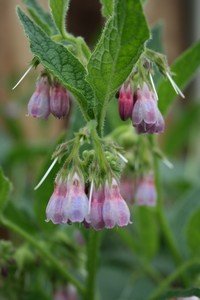 Comfrey helps with
fractures
and lives up to its old name of 'knit
bone'. By removing inflammation surrounding the fracture it induces a
union of the affected parts. Analysis has shown that it actually
contains allantoin, a crystallizable substance which is used in
orthodox medicine to encourage epithelial formation in ulcers and
wounds.
Comfrey helps with
fractures
and lives up to its old name of 'knit
bone'. By removing inflammation surrounding the fracture it induces a
union of the affected parts. Analysis has shown that it actually
contains allantoin, a crystallizable substance which is used in
orthodox medicine to encourage epithelial formation in ulcers and
wounds. 
Slippery Elm
as a herbal
medicine holds a very high place in herbalism
and many herbalists use it as a general healing agent. It is derived
from the inner bark of an Elm tree, the Ulmus fulva, which grows in
Canada and the United States of America. The powdered bark is both a
food and a medicine. It poultices and nourishes so that in cases of
gastric ulcers or for any internal wound it not only heals, but feeds
while it heals.
Every part of the Elder tree is a natural salve and so safe that it can
be used by anyone, internally or externally; so can the common
Marigold, and the lotion made from it which we call Calendula is a
great antiseptic. It not only heals the scars that follow an operation,
but promotes healthy tissue when it is diseased.
Leopard's Bane
(Arnica)
makes another useful lotion
in injuries, but it
is not nearly so safe as Calendula and should only be used in
homeopathic form.
We even have in the plant world a substitute for collodion in the
curious herb called Siegesbeckia.
This is a common weed in China, and
the juice applied to wounds produces a protective film.
Even in the middle of winter when other plants are vegetating the
Snowdrop will provide an excellent dressing for cuts and injuries.
Herbal Medicine versus Drugs
Interest in herbal medicine has developed greatly over the years, but there is still very little real understanding of the differences in principle between the actions and reactions of herbs and drugs. (I use the word 'drug' to mean any inorganic medicinal substance.) Many drugs are derived from plants, but the processes employed in their manufacture destroy or eliminate the organic properties that are retained when the same medicines are used in their herbal form.
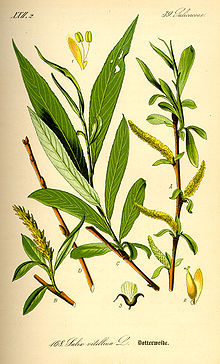 Aspirin, derived
from willow bark
and later the herb Meadowsweet
is a classic example of this.
Aspirin, derived
from willow bark
and later the herb Meadowsweet
is a classic example of this.
Taken as a herb, willow bark and meadowsweet have all the medicinal properties of aspirin without the negative side-effects that aspirin has.
However, when aspirin
was created, certain properties of willow bark were ignored, resulting
in the negative side effects such as stomach ulcers etc. that users
experience.
The idea of Paracelsus still persists in modern medicine today that violent diseases must be treated with strong medicines; but so many of the diseases the remedies for which have so far eluded medical science are the chronic ones.
And in such cases potent drugs, which can only be taken safely for a short time, leave the sufferer worse off than he was before, because he needs continuous treatment.
Herbal Medicine and How it Works on the Body
In herbal medicine, herbs, like drugs, are classified according to their action on the body.
1. Herbal Medicines that control the action of the muscles and relax spasms are called antispasmodics.
2. Herbal Medicines that subdue pain are called anodynes.
3. Herbal Medicinesthat cause perspiration are called diaphoretics.
4. Herbal Medicines that alter the constituents of the blood are called alternatives.
5. Herbal Medicines that
tighten up relaxed membranes and muscles and allay hemorrhage, either
active or passive, are the astringent
herbs.
So, like drugs, medicinal herbs are grouped as astringents, antispasmodics, anodynes, diuretics, emollients, emetics, expectorants, febrifuges, etc. But one herb can belong to several groups. The same herbs can be both astringent and diaphoretic.
Indeed, most herbs belong to more than one group, and some
have as
many as five or six different actions on the body.
This is one of the reasons why most herbs can be used in the cure of
many different diseases. To the lay mind these varied functions of
herbs are confusing and are probably responsible for the idea,
prevalent among the uninitiated, that herbs are a sort of faith cure.
Actually there are other reasons why the same herbs are used
to
cure divers complaints.
The similarity between drugs and herbal medicine ends with this
physiological action that groups them in classes; for the therapeutic
principle of a herb is quite different from the therapeutic principle
of a drug. A drug is, or should be, administered to relieve symptoms;
the right herb cures by removing the causes of the symptoms, and this
herbal healing process generally provokes an aggravation of the
symptoms at first. Such reactions are nature's way of restoring health
to the body.
In a normally healthy person, rest, warmth, fresh air, sunshine and
freedom from worry will cure without the addition of any medicine, but
when disease germs have become too well established, or the
constitution is naturally weak, herbs are needed to reinforce nature
and will always produce a quicker cure than nature unassisted.
But it is important to remember that the methods are the same.
For instance, nature's favorite way of killing disease germs is to
raise
the temperature of the body, because germs cannot remain alive in a
high temperature. This raising of the temperature is a very usual
reaction produced by herbs when they are administered to those
suffering from infections of any kind.
But nature and the herbs have other ways of eliminating
toxins. The
skin is a great eliminator and eruptions often follow the internal use
of herbs, disappearing sooner or later, and then the condition of the
skin is greatly improved.
With regard to the treatment of wounds by herbs the first consideration
as in orthodox medicine is to render the injured area antiseptic. After
this is achieved herbal treatment differs in several respects from the
effect of drugs. To start with herbs are administered to the wounded
internally as well as externally, and this results in elimination of
poison and promotion of healthy tissue.
Under herbal treatment no wound begins to heal until all poison is
eradicated, and therefore the healing process is often slower than
under orthodox treatment when the main idea is to close the wound
whether the poison has been eliminated or not.
Occasionally the cure is interrupted by a rise in
temperature. In
cases where a considerable amount of blood has been lost before the
wounded received medical attention, herbs would render a blood
transfusion unnecessary because of their action on the spleen. and
other ductless glands.
Nearly every herb, in fact I would say that practically every herb,
has, either directly or indirectly, an action on the blood; and this is
another reason why the same herb can be used to cure more than one
disease; for, in the herbalist's view, most chronic complaints are
primarily due to obstructions in the blood or to a toxic condition of
the blood, or to a lack of certain constituents that should be in the
blood of every healthy person. An alteration in the chemistry of the
blood can be effected by the action of plant hormones on the ductless
glands of the human body and by the catalysing enzymes which herbs
contain.
Enzymes are only found in the vegetable kingdom and when they exist in
animal products such as milk and butter it is because cows are
herbivorous animals. Enzymes are particularly interesting because they
cause fermentation and this is why fermented liquor can be made from
any herb, vegetable, flower, fruit, berry or tree, indeed from anything
that grows on the earth.
When a herbal medicine is prepared from an infusion of the dried plant,
the enzymes are liberated ; and when a herbal extract or tincture is
prepared by a cold maceration of a fresh plant, the enzymes are
preserved. So herbal medicines contain these valuable enzymes, these
living cells of the plants, and other medicines do not contain them,
which is one of the reasons why herbs successfully cure so many chronic
diseases, particularly the allergic ones.
Enzymes are catalysers which have the power of altering the
mineral
constituents of the blood, and causing them to adjust themselves into
the right ratio to each other. For when these constituents are
maladjusted and out of correct proportion, ill health follows. These
enzyme catalysts can also bring about chemical changes in the toxins.
The elements of which herbs are composed are oxygen, hydrogen, carbon,
lime, potash, iron, ammonia and magnesium.
Plant life with the help of chlorophyll transforms these into starches,
sugars, gums, resins, mucilages, oils and acids so herbs are foods as
well as medicines.
The vegetable organism combines a physical as well as a
therapeutic
constitution and this brings us to another important difference between
herbs and drugs. Herbs stimulate the phagocytes by improving and
building up the general health and so they actually reduce the disease
germs. Drugs merely produce a latent effect on the
germs by driving them into a position where they are for the time being
inactive.
The processes of nature are so complicated, and one substance is so
dependent on the presence of another, that it seems reasonable to
believe that the whole plant yields better results in medicine than any
isolated substance or substances.
The reason why the alkaloids only are used in orthodox medical practice
is because this is the only way of standardizing the medicinal herbal
products. Experience, however, proves that the herb in its natural
form, with all its tonic substances, immeasurable as they may be, does
produce not only quite different results, but that the cures wrought by
their agency, though slower, are more permanent.
Furthermore, when the herbal derivatives are prescribed in the form of
drugs they are administered in much larger doses and in more
concentrated form than they are found in the plants themselves.
So that their action is quite different from the action of the
same
substance administered in the infinitesimal small quantity as it exists
when in the plant itself, as it is then given naturally combined with
its appropriate potash salts, and with the nutritious ingredients of
the plant in their proper proportions. The active difference is that
the large dose tends to suppress, the small dose to eliminate the
toxins with which they have affinities.
Tradition is at present a more helpful source of information on which
to acquire a knowledge of the healing powers of particular plants than
science, because tradition has borne the test of thousands of years of
experience; and science can pronounce no verdict in the absence of
laboratory tests.
Many of the ingredients in herbal medicines give no reactions
in the
chemical laboratory and defy analysis. When a compound medicine of
drugs and herbs is analysed the herbs in it cannot be detected and are
therefore regarded as negligible, although their presence may account
for a chemical change in the other constituents, and, undetectable as
they are, may have a catalysing influence on the toxins of the body.
Finally, to come to the value of medicinal herbs not only in the
healing of wounds, but in the restoring of health and strength, it is
difficult to overrate their importance because of their beneficial
action on the blood stream and on the ductless glands. So in the cure
of diseases that have become chronic I do not believe they have an
equivalent in medicine.
Wild Herbs for Herbal Medicine are All Around You
Euphorbia
grows about the
sacred fountain of Castalia, near the site
of the Delphic oracle; Yellow Broom is in blossom all round the theatre
at the famous healing Temple of Aesculapius at Epidaurus; Pimpernel and
Hawkweeds
flourish at Troy,
outside the walls of Priam's city; the
stony Sicilian mountains near the Temple of Segesta are covered with
Valerian, Yellow Mustard,
orange colored Marigolds
with huge clumps of
Yellow Fennel,
a riot of color
accentuated by the crops of cherry red
Fenugreek
cultivated in the
valleys.
The very names of the flowers that star the earth like the names of the
stars that flower in the heavens are timeless links with the people in
whose knowledge and wisdom our western civilization is rooted. It is
not only the romantic names of such flowers as Narcissus and Hyacinth
that carry our imaginations back to that age of the gods and heroes,
the scientific names of medicinal plants come to us in direct descent
from Galen
and Aesculapius
Centaury, Paeony, Valerian,
Artemisia,
Sempervivum, Dittany, Euphorbia, Myrtle, Salvia, etc.
And the familiar English names of so many of our wayside plants are
derived from their medicinal properties and are witnesses to the
age-long practice of our forebears. In herbal practice today they are
still used for the complaints from which they have derived their names
Ague Tree, Feverwort, Bruisewort, Rupturewort, Quinsey Berry, and
Madwort are
some of them.
Other names apply to the organs of the body for which they are
particularly adapted Lungwort,
Spleenwort, Liverwort, Kidney Wort,
Navel Wort, Blood Wort, Mouth Wort, Throat Wort and Eyebright.
It is a comforting thought that these useful medicinal herbs are the
wild plants that grow so lavishly here and in other countries, the
Dandelion
and Plantain,
Daisies and Buttercups, Cowslips, Saxifrages
and Potentillas
even the
despised Darnel
and all the
idle weeds that
grow in our sustaining corn they are all a gift to mankind. They are
for the healing of the nations.
A Quick Reference Chart of Herbal Medicine that will Help Everyday Ailments
| AILMENT | HERB |
| Acne | Aloe vera, Burdock, Calendula, Dandelion, Nettle, Tea Tree oil |
| Alcoholism | Evening Primrose, Kudzu |
| Alzheimer's Disease * Aids memory, does not prevent tissue die off. | Ginkgo, Rosemary |
| Angina | Hawthorn, Garlic, Green Tea, Willow |
| Anxiety and Stress | Chamomile, Hops (Do not take hops if you suffer from depression), Kava, Lavender, Passionflower, Valerian |
| Arteriosclerosis | Garlic, Ramsons, or Wild Wood Garlic, sometimes known as Bear Garlic is even better |
| Arthritis | Birch Leaf Tea, Burdock Leaf (Poultice), Comfrey, Dandelion, Guelder Rose, Meadowsweet, Wild Sweet Cherry, Willow |
| Asthma | Agrimony,Chickweed, Coltsfoot (minor asthma), Honeysuckle, Nettles |
| Attention-Deficit Hyperactivity Disorder (ADHD) | Hawthorn |
| Bad Breath | Parsley |
| Boils | Crushed Blackberry Leaves, Burdock (poultice), Coltsfoot and Honey (poultice), Mallow (poultice) |
| Bronchitis | Chickweed, Coltsfoot Tea, Comfrey, Echinacea, Honeysuckle, Mullein Tea, Plantain, Sweet Wild Cherry |
| Burns | Aloe Vera, Nettles, Oak, Pellitory, Plantain |
| Cancer * (Preventing) | Bilberry, Blackberry, Dandelion, Garlic, Green Tea, Ginseng, Maitake Mushrooms, Pomegranate, Raspberry, Reishi Mushroom |
| Cellulite | Birch Leaf Oil |
| Circulation | Elderberry Flowers, Guelder Rose, Hawthorn, Nettles, Ramsons, Teasel, Wood Betony |
| Colds | Echinacea, Elder, Ginseng, Honeysuckle, Horseradish, Licorice Root, Lemon and Honey, Mint, Raspberry |
| Constipation | Apple, Red Clover, Dandelion, Deadnettle, Mallow, Senna |
| Cough | Chickweed, Coltsfoot, Elder, Horseradish, Mallow, Mint, Mullein, Plantain, Red Clover, Sweet Cherry |
| Cystitis | Agrimony, Birch Leaf Tea, Couch Grass |
| Depression, mild to moderate | Betony, St. John's Wort, Wild Rose |
| Diabetes, Type 2 | Beans (Navy, Pinto, Black etc.), Cinnamon, Flax Seed, Green Tea, Nettles |
| Diarrhea | Bilberry, Blackberry Leaves, Dock, Meadowsweet, Nettles, Oak Bark and Leaves, Raspberry Leaves, Rosebay Willow Herb (fireweed), Self-Heal, St. John's Wort, White Deadnettle |
| Diverticulitis | Meadowsweet, Peppermint |
| Dizziness | Ginger, Ginkgo, Lycium (Goji Berry) |
| Earache | Echinacea, Mint, Mullein, Yarrow |
| Eczema | Chamomile, Birch Tea, Borage Seed Oil, Burdock, Chickweed, Curled Dock, Dandelion, Nettles, Primrose Oil, Red Clover |
| Fatigue | Ginseng, Teasel, (chronic fatigue/ME), Vervain (chronic fatigue/ME) |
| Flu | Echinacea, Blackberry Leaves, Elderberries, Honeysuckle, Horseradish, Linden, Meadowsweet, Mint, Raspberry Leaves, Self-Heal |
| Gingivitis | Goldenseal, Blackberry Leaves |
| Hay Fever | Elderflower, Nettles, Plantain |
| Herpes | Birch, Echinacea, Garlic, Ginseng, Pellitory, Self-Heal |
| High Blood Pressure | Dandelion, Lycium (Goji Berries), Guelder Rose, Hawthorn, Linden, Nettles, Self-Heal |
| High Blood Sugar | Bilberry Leaves |
| High Cholesterol | Dandelion, Evening Primrose Oil, Hawthorn, Linden, Lycium (Goji Berry) |
| Hot Flashes/Flushes | Black Cohosh, Elderflower Tea, Honeysuckle, Hops, Linden, Red Clover, Self-Heal, Vervain |
| Impotence | Lycium (Goji Berry), Wild Rose |
| Indigestion | Chamomile, Ginger, Mallow, Meadowsweet, Mint, Peppermint, Sweet Cicely |
| Infection | Astragalus, Echinacea, Burdock (Poultice), Dandelion, Nettles, Ramsons |
| Insect Stings | Plantain |
| Insomnia | Hawthorn, Hops, Lemon Balm, Linden, Valerian, Vervain, Wild Rose, Wood Betony |
| Irritable Bowel Syndrome (IBS) | Guelder Rose, Hops, Mallow Tea, Ramsons, Red Poppies, Rosebay Willowherb Leaves, White Deadnettles |
| Lower Back Pain | Willow |
| Menstrual Cramps | Guelder Rose, Linden, Mullein, Raspberry Leaves, |
| Migraines | Feverfew, Guelder Rose, Honeysuckle, Meadowsweet, Vervain, Willow |
| Mouth Ulcers | Aloe vera, Bilberry Leaf Tea, Meadowsweet, Mint, Oak Bark, Plantain, Raspberry Leaf Tea, Rosebay Willow Herb, Self-Heal |
| Muscle Pains | Teasel, Birch Leaf Oil, Dandelion Flower Oil, Horseradish, Meadowsweet, Willow |
| Nausea | Mint, Raspberry Leaf Tea |
| Prostate Problems | Couch Grass, Horsetail, Nettles, Pellitory, Red Clover, Rosebay Willowherb |
| Sinus | Honeysuckle, Horseradish, Mint, Thyme, Wood Betony |
| Slimming and Weight Loss | Chickweed |
| Tonsillitis | Cleavers, Honeysuckle, Oak Bark |
| Toothache | Linden, Mallow, Mint, Plantain, Willow Bark, Yarrow |
| Varicose Veins | Bilberries, Comfrey (Poultice), Horse Chestnut, Lycium (Goji Berry), Plantain (Poultice), White Deadnettle, Wood Betony, Yarrow |
| Worms | Agrimony, Mugwort, Wormwood |
Leave a Comment or a Picture of ways in which you Use Medicinal Herbs
Do you have anything that you would like to add after reading this page? We would love to hear your thoughts. If you can add additional information to what has been written here you will be adding value to the website! No need to have any special skills - just type and submit. We will do the rest!
Leave a Comment
Do you have anything that you would like to add after reading this page? We would love to hear your thoughts. If you can add additional information to what has been written here you will be adding value to the website! No need to have any special skills - just type and submit. We will do the rest!




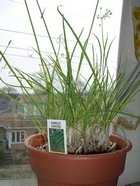
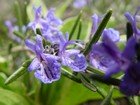
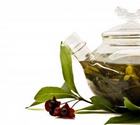

New! Comments
Do you have something of value to add? Leave me a comment in the box below.